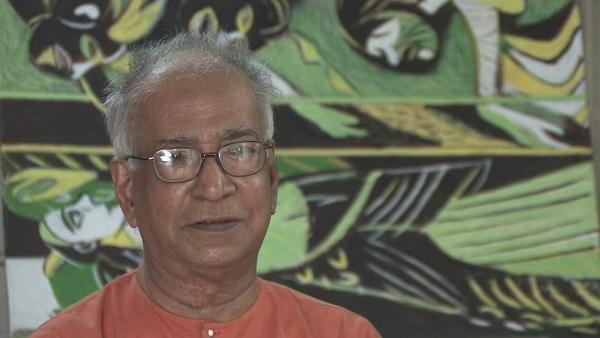NEXT STORY

Santiniketan in the 1980s and the freedom to work
RELATED STORIES

NEXT STORY

Santiniketan in the 1980s and the freedom to work
RELATED STORIES


|
Views | Duration | |
|---|---|---|---|
| 51. Hybrid art | 49 | 04:48 | |
| 52. Stella Kramrisch | 276 | 02:17 | |
| 53. Leaving Baroda in 1980 – I was becoming like a mother hen | 35 | 09:37 | |
| 54. My studio and extended family in Baroda | 53 | 02:45 | |
| 55. Santiniketan in the 1980s and the freedom to work | 43 | 01:40 | |
| 56. Where I am today | 43 | 01:37 | |
| 57. My book of essays Moving Focus | 111 | 05:00 | |
| 58. The Bengali revival | 53 | 03:47 | |
| 59. The Kolkata University lectures | 1 | 49 | 02:40 |
| 60. Changes in the art world – effects of the... | 1 | 66 | 07:10 |


When you were living in Baroda, you were sharing – not sharing but you were living in the same residency bungalow that Sheikh and Bupen were also living in?
That’s right.
So you saw them quite a lot, then?
Yes, I did. Really speaking, that residency bungalow, that is after I came back from Bombay. I wanted a larger space to work, so I had told the vice chancellor well, if you can give me a place where I can easily work. Then he allotted me a house. The residency bungalow before that was used as an office at one time. Then the office had a new building so they had moved out. So when they did that, they had allotted me another house which was a sort of an old colonial house which they couldn’t in the end give it to me. Then the vice chancellor at that time said there is this place, would you like to? So I went and saw it and said that if you give me the whole upper floor, then I am interested, and he very generously did. Then nobody else wanted to come there to live because it was a little further away and people were... but the people who were, were artists. So Sheikh and Nilima was just going to be married there at that time, and there were, I think Jeram Patel was in the other portion, and in the front two others came. I mean, they were in different disciplines, but before them, we had two Americans there. They had come on what they called the Urban Community Project to help, and one was, I think, Dr Cousins and one Abraham. Abraham was, I think, a Quaker, and then sort of head of a Quaker agency, but they were all sent here through an American aid programme. That programme probably continues here as an NGO of some kind, but they used to stay there. Like that, various other people used to say there too. I mean, especially Fulbright professors, but these three were people known to me, that’s right. We stayed there. So we used to, it used to be like a sort of an extended family.
KG Subramanyan (1924-2016) was an Indian artist. A graduate of the renowned art college of Kala Bhavana in Santiniketan, Subramanyan was both a theoretician and an art historian whose writings formed the basis for the study of contemporary Indian art. His own work, which broke down the barrier between artist and artisan, was executed in a wide range of media and drew upon myth and tradition for its inspiration.
Title: My studio and extended family in Baroda
Listeners: Timothy Hyman
Timothy Hyman is a graduate of Slade School of Fine Art, London, in which he has also taught. In 1980 and 1982, he was Visiting Professor in Baroda, India. Timothy Hyman has curated many significant art exhibitions and has published articles and monographs on both European and Indian artists.
Duration: 2 minutes, 46 seconds
Date story recorded: 2008
Date story went live: 10 September 2010